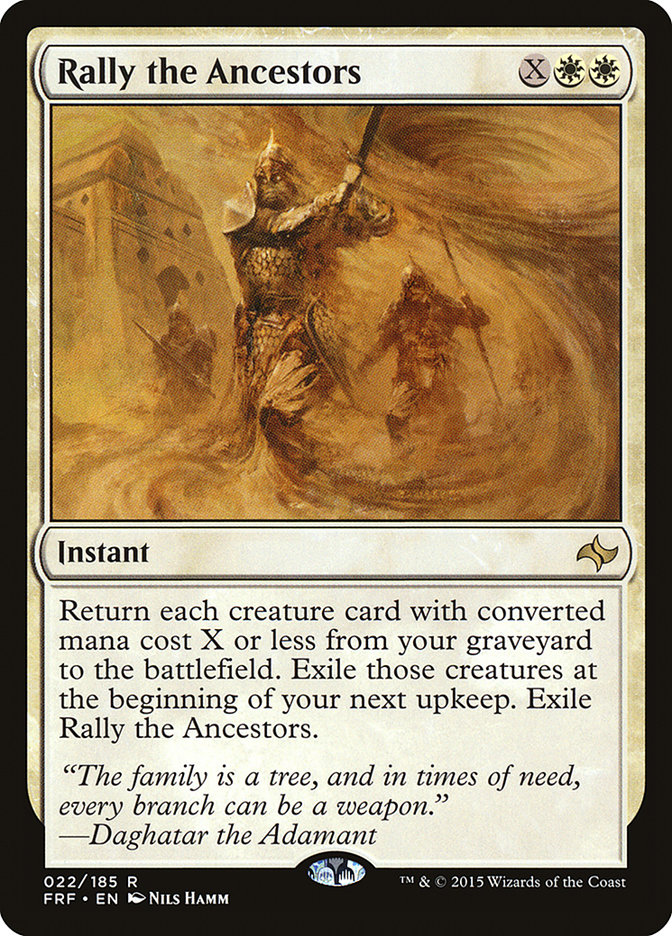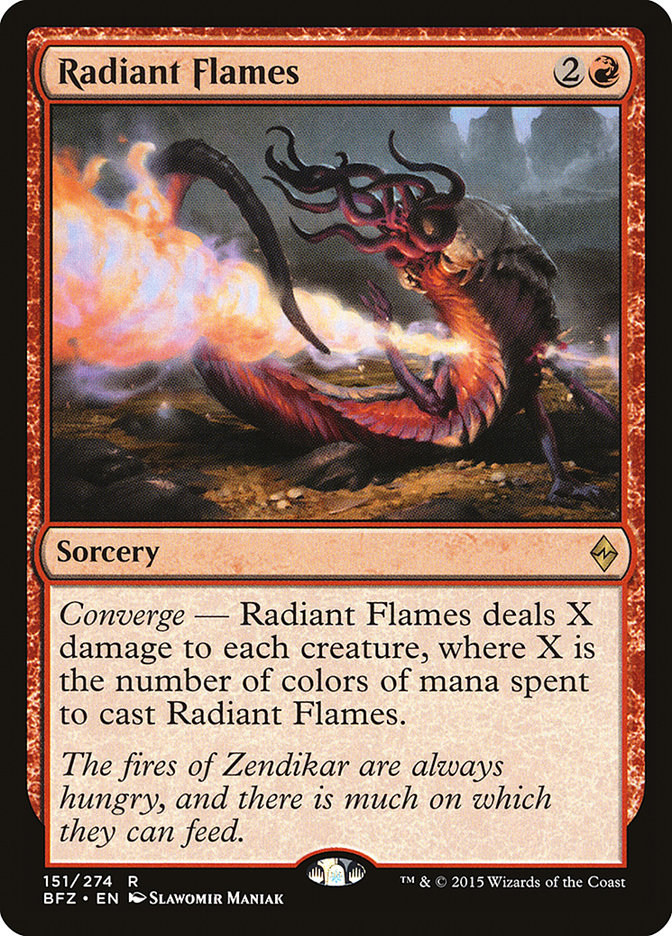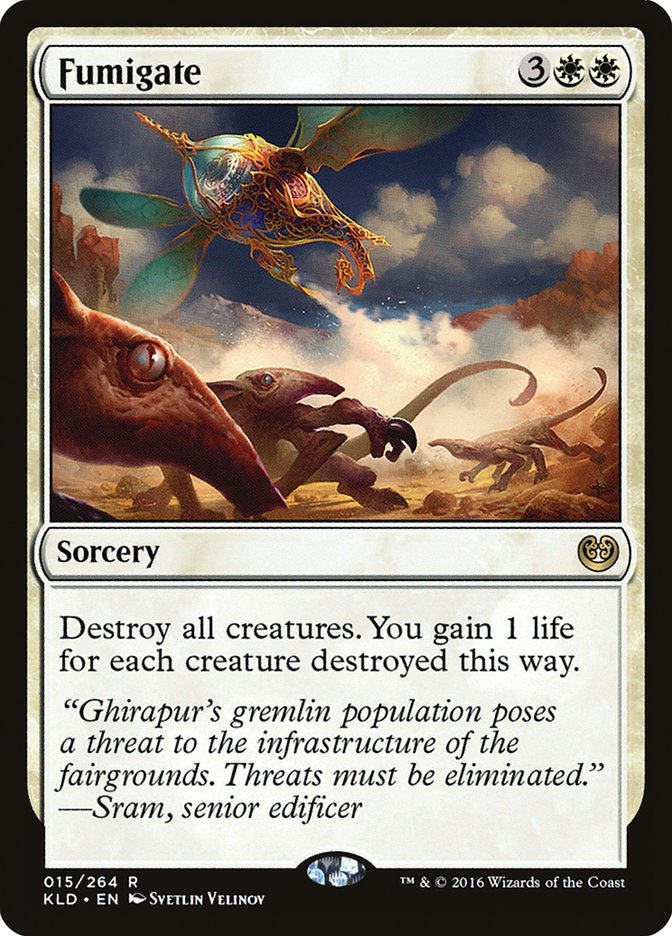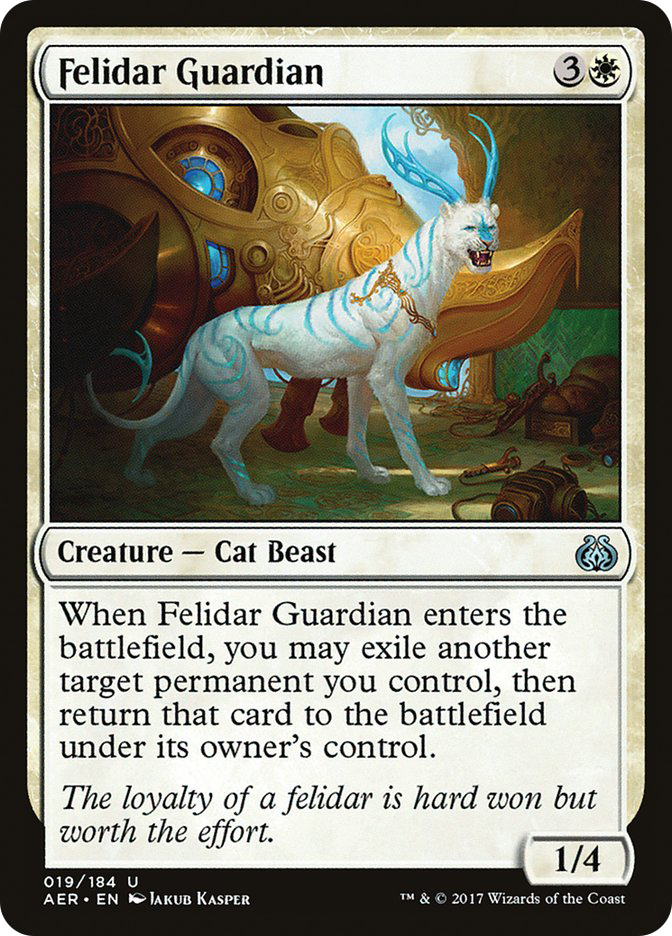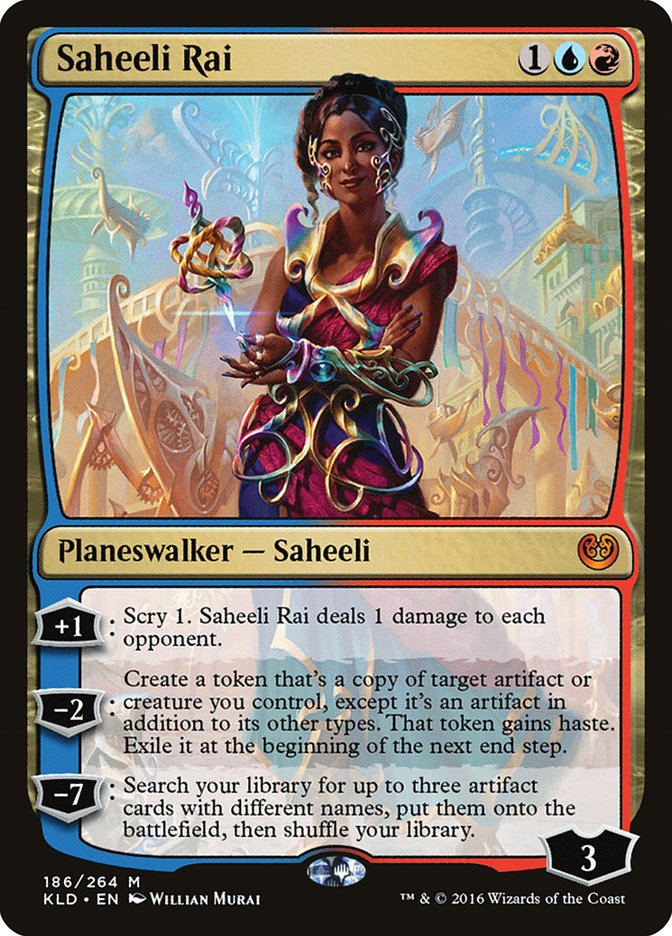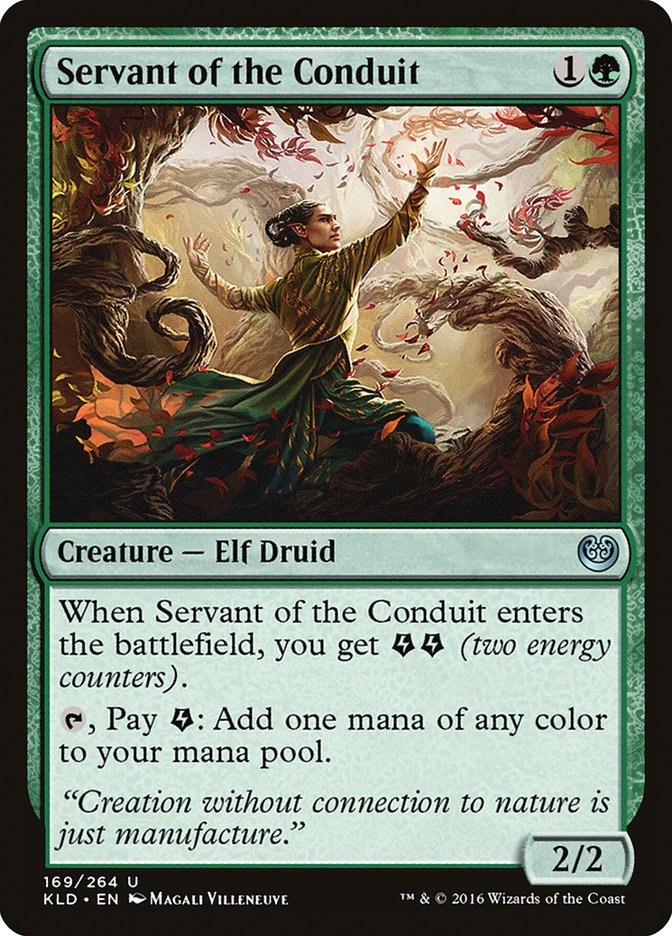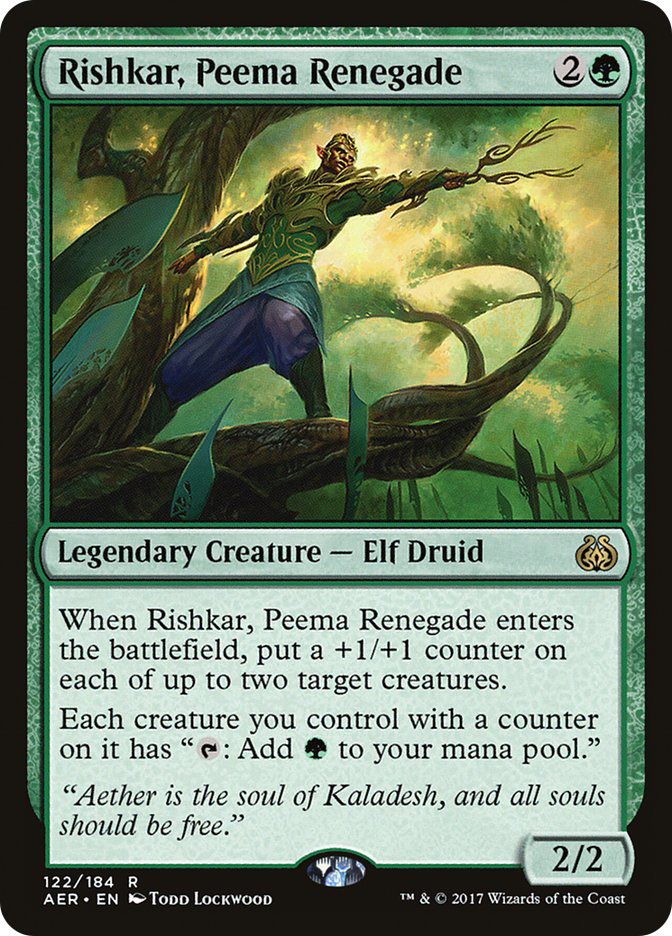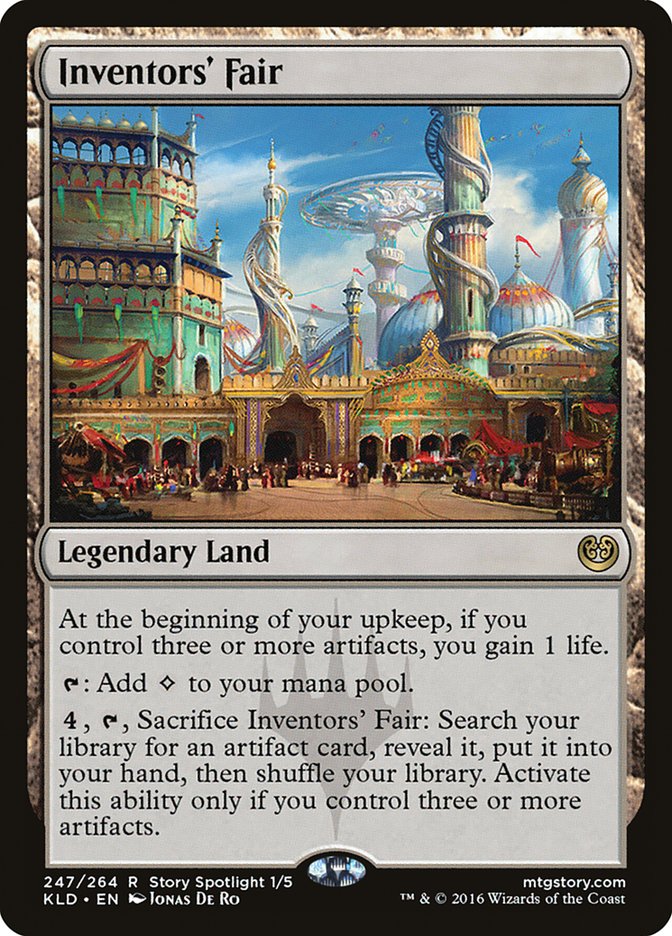The entire Aether Revolt set got published last Friday. Like with any other set release, my mind went racing to see what this set could do to stop the state of Standard we’ve currently been in. To my disappointment, the set felt a little lackluster. It just didn’t have the tools to fight the war we’ve been losing for months now.
It didn’t have to.
By Monday three of the format’s biggest offenders were banned by Wizards of the Coast, an unprecedented move by the company to keep us excited and Magic interesting. I for one am happy about this decision, but scared this may be setting a new status quo.
Standard’s in a really peculiar place right now. The sets being published were intended to live through a fifteen- to eighteen-month cycle, but a change in policy has caused that maximum lifespan to extend all the way back up to 24 months like it did not so many years ago. This may seem subtle and potentially irrelevant from a game design standpoint, but at the same time it would make sense that some cards would be made extremely powerful for a shorter shelf life.
Going back to the old rotation system doesn’t make much sense in a two-set-block world. This means that every other block will always be tied in with the previous one. For example, Innistrad’s stuck with Zendikar, and Amonkhet’s entwined with Kaladesh. This lack of privacy between blocks may cause certain keywords intended for Constructed play to never see the light of day thanks to other, more powerful designs. Well, without Wizards stepping in and doing something about it like they’ve just shown us they would.
Now, I’m content with the company owning up to their mistakes and doing something about it for the better of the game. What I’m now afraid of is more aggressive design met with impromptu bans. Balance isn’t easy from a design/development perspective, but consistency shouldn’t be something we simply hope happens. It’s deserved from a consumer standpoint, and something I don’t think we’ve been given for a few years now. I stand by the makers of my favorite hobby turned profession; I just ask them to find the direction they want to go in and keep us informed.
On a micro-level, this specific banning in Standard will make things better. Emrakul, the Promised End was causing significant problems in Standard since its release. It seemed like it would have been the most influential card for its duration in Standard which is something we as players get sick of. Smuggler’s Copter was taking over how the early-game functioned in almost all the decks not playing Emrakul, the Promised End, and it seemed like that wouldn’t change for some time. These two cards got banned due to warping both the early- and late-game of an entire format. Their absence will open up many new play patterns, which is exactly what we as Magic players want.
So what about Reflector Mage? Why did it have to go after being so dominant for an entire year? My best guess is its continued ability to be abused is why it got the axe. It all started with Collected Company; moved on to protecting Gideon, Ally of Zendikar; and now threatens to be the backbone of the Saheeli Rai / Felidar Guardian combo, given it combos with both pieces. The risk just wasn’t worth it for Wizards, and thus Reflector Mage got caught up in this unique Standard banning.
So now we have a practically new Standard format. Three of last season’s most hindering cards are gone, while Aether Revolt dropped 184 new ones on our lap. So what do we do?
Control Panel
Well, for starters, if you enjoy control decks, you rejoice. Aggressive decks attacked from many different angles, making it difficult to control them effectively given how situation removal has gotten. Creatures, Vehicles, and Planeswalkers all together formed this proactive “test” control decks had to pass. To do so properly, they needed an array of different spells, which could cause them to be too reactive when it came to the Emrakul, the Promised End test. Being pulled in multiple directions was the downfall of control, but not anymore.
Control strategies don’t have to worry about streamlined aggressive decks that could get around cards like Radiant Flames or Fumigate by having so many uniquely different proactive elements. Sure Gideon, Ally of Zendikar and the new Heart of Kiran will continue to allow aggressive decks to “dodge” mass removal, but it won’t be as easy to do as it previously was. Another benefit for control decks that will be the major talking point for today is their new ability to have a combo finish.
So here it is in all its glory, the combo that probably shouldn’t exist but does. It’s being dubbed the “Splinter Twin Combo,” but in all honesty that undersells how good the combo of Felidar Guardian and Saheeli Rai is going to be. You don’t have to worry about summoning sickness or holding up mana at specific times to win the game once assembled. You just have to get them both onto the battlefield and have something not interact with one of the two pieces in that small window. That’s it! You can cast Fumigate and all of a sudden win on the very next turn. That’s downright busted!
Control decks always seem to flourish when they can have a combo-based win condition. That’s because they get to play normalized reactive Magic but can all of a sudden with the game when the opponent taps out or simply doesn’t “have it.” That’s a very powerful place to be for a control deck, since you get to react to them. If they hold up mana, you can just draw more cards with Glimmer of Genius. If they tap out, you can kill them! All of this while you inch closer to six mana for Torrential Gearhulk, who does a great job at stabilizing a battlefield, and forcing them to use their mana to keep up. Can’t assemble the combo in the late-game? Well, don’t worry about it when both parts of the “copy Cat combo” also interact favorably with Torrential Gearhulk.
This is ground zero. Jeskai Saheeli is the biggest enemy that we have to build, learn from, tune, and eventually understand how to beat. It’s no longer B/G Delirium, Mardu Vehicles, or W/U Flash. Jeskai Saheeli is “the” deck to care about right now. Maybe it ends up not being as good as some of us predict. Who knows, it could even be broken and banned within the next two months. All that’s certain is the importance for us to find out.
Creatures (7)
Planeswalkers (4)
Lands (26)
Spells (23)

This is my starting point for testing. If you look closely, this is simply the shell of the Jeskai Control list Bradley Hill used to take second place at #SCGKNOX last year, but with the addition of the combo. Normally the starting point for a metagame tends to be the aggressive shells, then the control strategies targeting those aggressive decks, and finally the midrange decks trying to balance between the polarizing elements. Rarely do we begin with a Combo/Control deck like Jeskai Saheeli, but that’s the reality we found ourselves in.
The removal of Smuggler’s Copter plays an important role in why we must do this. It’s difficult to reformat our ideas about what an aggressive deck should look like in Standard, since we’ve become so familiar with Smuggler’s Copter being the base of any aggressive deck. It’s tough, but we must switch things around and work backwards.
So what did Smuggler’s Copter do to the format that you now must banish it from your mind? This is actually a tough question to answer, in all honesty. Smuggler’s Copter gave every deck a great two-drop that now needs to be replaced in every strategy. Luckily there are a few new ones and also a couple of oldies that got pushed out by the powerful vehicle. One in particular, however, is poised for a great breakout performance at Pro Tour Aether Revolt.
Walking Ballista is no Hangarback Walker, but it does serve a purpose in this new format. For starters, it interacts favorably with a slew of cards. Winding Constrictor; Nissa, Voice of Zendikar; Oath of Ajani; and Rishkar, Peema Renegade all work well to get additional counters on this card, but its built-in ability to grow can also push through damage in interesting ways. The ability to grow-and-throw counters lets you attack smaller creatures into bigger ones. Sure, you might waste your turn, but the trade up might be relevant enough to do so.
I’ve had limited testing with this card, but in that small window this card has impressed me. Nothing’s been more impressive than its ability to deal with the Saheeli Rai / Felidar Guardian combo all on its own.
Saheeli Rai has to drop down to one loyalty each time you loop the combo. This is the window for Walking Ballista to deal one damage to a player and send Saheeli Rai to the graveyard by redirecting the damage. Of course, a removal spell prior to the combo will leave Walking Ballista doing relatively nothing, but that’s a problem all in itself. The ability to stop the combo when tapped out is something many decks will be looking for, and being colorless allows Walking Ballista to potentially find a spot in any deck.
Creatures (25)
- 2 Kalitas, Traitor of Ghet
- 4 Verdurous Gearhulk
- 4 Scrapheap Scrounger
- 4 Servant of the Conduit
- 4 Winding Constrictor
- 3 Rishkar, Peema Renegade
- 4 Walking Ballista
Planeswalkers (4)
Lands (25)
Spells (6)

My biggest prediction going into this new Standard format is that decks will have to be built with an extremely low curve so that you can hold up mana in the mid-game while still advancing your battlefield position. Walking Ballista plays well with this strategy, since it can be cast for multiples of two while also having an ability to sink extra mana into. The same can be said about Scrapheap Scrounger. The curve in this deck may seem low, but that doesn’t mean we don’t have things to do with extra mana, which is extremely important.
Mana creatures like Servant of the Conduit and Rishkar, Peema Renegade will also be important tools to allow us to cast our more powerful cards like Verdurous Gearhulk while still keeping mana up for Grasp of Darkness. I know it sounds silly, but tapping out any time after they have five mana can be lethal, which is why we must protect ourselves from it at all costs. They never said it was going to be easy!
The Inventors’ Fair was designed to bring wild and crazy inventions to Kaladesh, but Saheeli Rai doesn’t really want to share first place. Most of the brews we are going to see moving forward are going to have Saheeli Rai and Felidar Guardian instead of utilizing some of the other crazy cards to come out of Aether Revolt. My prediction is that Jeskai Saheeli will be the most powerful, but hopefully we can see decks like this doing something in the format:
Creatures (22)
- 2 Pilgrim's Eye
- 4 Eldrazi Skyspawner
- 4 Thraben Inspector
- 4 Cloudblazer
- 4 Glint-Nest Crane
- 4 Felidar Guardian
Planeswalkers (4)
Lands (24)
Spells (10)

What I love most about this deck is its ability to combo off without Saheeli Rai. With Panharmonicon on the battlefield, two Felidar Guardians can blink one another in and out of the battlefield, along with an additional permanent with each permutation of the combo. So for starters, we will end up with arbitrarily large mana, but after that we can have arbitrarily large Clues with Thraben Inspector, drawing as many cards as we want with either Prophetic Prism or Cloudblazer, or my favorite combo: stacking our deck with Glint-Nest Crane. All four ways allow us to find Saheeli Rai and actually win the game, but having more than one way to blink a cat is always the way to go.
This has been quite the interesting week in Magic, but the actual fun starts this weekend. Players from all over the world will be opening packs of Aether Revolt. Some are grizzled veterans of the game, while others may be experiencing tournament Magic for the first time. It is our job as ambassadors of the game to make sure that everyone at our local game stores are having a fun time. I know the game can get competitive at times, but make sure that your opponents are still having a wonderful experience. You may be the difference between a one-timer and someone who will eventually love the game as much as we do.
I’ll be back next week with a better understanding of what Standard looks like without Smuggler’s Copter and with a two-card combo. Until then, let me know what you think is going to be important as we try to crack this puzzle Wizards just dropped on us.



